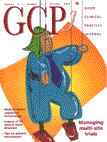|
|
The biostatistician now enjoys a high profile within the pharmaceutical industry and is involved at every stage of a clinical trial. Fiona Jones interviewed Patricia Collins, biostatistician with a leading CRO, and was persuaded that statistical input, especially in the early phases, is vital in ensuring the accuracy and reliability of the trial results. |
GCPj Volume 6 |
|
Statistics - The great tragedy of science or the most important science in the whole world?The great tragedy of science - the slaying of a beautiful hypothesis by an ugly fact. Aldous HuxleyThe most important science in the whole world: for upon it depends the practical application of every other science and of every art: the one science essential to all political and social administration, all education, all organisation based on experience, for it only gives results of our experience. Florence Nightingale.Opinion on statistics, and indeed on statisticians, tends to fall into one of two extremes. I most confess my thoughts tend to favour the view of Alodus Huxley! I therefore welcomed the challenge to interview Patricia Collins, biostatistician with one of the leading CROs, in the hope that she could enlighten my beliefs. |
 |
Paticia’s BackgoundPatricia works on contract to the pharmaceutical industry for 3/4s of the year. In the five years she has been in her present job, she has worked on site for most of the top twenty pharmaceutical companies in locations throughout Europe. Indeed, when I met with Patricia she was working on a contract that enabled her to live in France for six months and to take regular excursions to visit colleagues who were working in Switzerland. Since becoming a biostatistician, Patricia has seen the consolidation of various agreed principles and guidelines for using statistics in clinical trials. Before tackling her over the more practical aspects of her job, I questioned Patricia about these principles (particularly those that reached step 4 of the ICH process in early 1998) and asked her how their impact affected the way she worked. |
The Guidelines"The role of statistics in clinical trials is acknowledged as ‘essential’ in ICH E6. Guidance is clearly given to include: a description of the statistical methods, the level of significance, criteria for study termination, procedures for accounting for missing, unused, and spurious data, methods for reporting any deviation from the original statistical plan, and the selection of subjects to be included in the analyses. In Topic E8 we read that ’A description of the statistical methods to be employed, including timing of any planned interim analysis(es) should be included in the protocol.’ In addition ICH E3 gives clear guidance to include information in the clinical trial report, statistical information including: adjustments for demographic measurements, handling of dropouts or missing data, any interim analysis performed, and ‘efficacy subsets’ etc. However, the proliferation of statistical research in clinical trials coupled with the critical role of clinical research in the drug approval process has necessitated the need for a document specifically related to the statistical issues related to clinical trials - ICH E9 Statistical Principles for Clinical Trials. This latest guidance aims to provide more specific direction in the design, conduct, analysis, and evaluation of clinical trials in the context of its overall clinical development. The overall objective being, of course, to harmonise the statistical methodology being applied to clinical trials in Europe, Japan, and the United states. The focus of the guidance is on statistical principles rather than specific statistical methods. The guideline has also raised the profile of the biostatistician assigning a specific definition to our role: ‘Trial Statistician - A statistician who has a combination of education/training and experience sufficient to implement the principles in this guidance and who is responsible for the statistical aspects of the trial.’ The role and responsibility of the trial statistician is ‘to ensure that statistical principles are applied appropriately in clinical trials supporting drug development. The ICH and other formalised guidelines make our job easier in a lot of ways: they provide a basis for training, they give advice when you are unsure of a specific issue, they give ‘weight’ to your arguments, and enable you to focus on the ‘real’ issues. I feel that the statistical issues where a bit scattered in the previous ICH documents but now with ICH9 the information is much clearer and more succinct." |
 |
What do biostatisticians do?Although I have read the guidelines, my first question to Patricia still had to be what exactly do biostatisticians (or indeed trial statisticians) do? |
|
"Statistical input is required throughout the entire trial process. Biostatisticians need to be involved in planning the study, determining the sample size, creating the randomisation lists, managing the data, analysing and interpreting the results. We also need to be involved in determining whether a trial should be terminated early or not and may be involved in investigating fraud and misconduct. It is therefore crucial that we have input at every level of the clinical trial process. In particular, involvement in the final report is essential to ensure that the results are correctly and unbiasedly interpreted. Clinical trials are full of problems and uncertainty. Decisions have to be taken, often quickly without knowing how they may affect future research and development of a product. In the ideal world everyone involved in a study would sit down and logically solve the particular issue. However the number of people involved, the complexity of the problems, the personalities involved and of course the costs make it difficult to be impartial about the result. The role of the biostatistician is to formalise the process of logical thought to assess the current situation and to determine the possible options and priorities. We then have the task of convincing the others! This process can be applied all stages of our work from determining the number of patients that need to be included in a trial, to giving guidance in determining what information is reliable and which predictions can be trusted, right through to determining the success or failure of a study. We also sometimes have a detective role searching for clues to the solution of a scientific conundrum, and can sometimes keep companies from being misled and making the wrong decisions based on false impressions." |
 |
Detectives and fraudI have always found that there is an aura of mystery surrounding the statistics department of any pharmaceutical company or CRO and I therefore enjoyed Patricia’s description of biostatisicians as detectives. I asked her if she felt that biostatisicians encourage this image. |
|
"Of course we do! As I mentioned before we often have to convince people who feel very passionate about their study or idea that it is not a logical plan and hopefully we are able to offer a suitable alternatives. If we can support this in a dazzle of complex figures it can often soften the blow." Patricia mentioned that statisticians might be involved in investigating fraudulent trials and study misconduct. Interestingly, in the US, the statistician has no regulatory status. Thus, if the statistician is unethical it remains the responsibility of someone else (sponsor, principal investigator etc.) I asked her what she thought of this rather unique position. "This is an interesting and indeed somewhat controversial aspect of clinical trials – particularly in some trials when it may be necessary to terminate a study early. In these cases there is usually a group, known as the ‘Data Monitoring Committee’ that is given the responsibility of taking periodic ‘peeks’ at the data. This is all performed in accordance with specific statistical protocols. These boards may be internal to the company, but are increasingly independent so as to ensure credibility to the study. The biostatistician has a major role in this process - especially when the interim analyses are designed to make a determination to stop or continue the trial. However, the regulatory authority rests with the FDA. Indeed it could happen, that a study may be stopped early, submitted to FDA and the FDA could disagree with the decision to prematurely end the trial. So biostatisticians play a critical role, but they do not act alone. In the case I mentioned to you ‘the board’ has a number of members who at a minimum will include clinical experts, research scientists, and possibly ethicists. The statistician may draw conclusions regarding the data, but it is a board decision to determine whether they should advise the sponsor to terminate early. The biostatistician has the responsibility to inform the sponsor if there are any suspicions about data integrity but the ultimate responsibility for the integrity of the trial remains with the sponsor. I think this is how it should be – the sponsor has recruited everyone associated with the trial including the biostatisticians." |
|
The problemsPresenting complex statistical data results in a clear and objective way is obviously a challenge. I asked Patricia what are the other problems faced by a biostatistician? "The main difficulty for me is getting a clear understanding of the therapeutic area under investigation and what is clinically of interest. Working for a CRO means that you are not limited to a particularly area of research. Other members of the team, such as the CRA or the principal investigator, will often have years of experience working within a particular therapeutic field and may be a expert in that area. It is important to learn as much as you can from them. Although it can be difficult to adapt and to learn quickly, for me it’s also one of the advantages of the job." |
 |
The highs and the lowsIt must, of course be satisfying to perform the statistical analysis and have the results show that the trial has been successful, Patricia shared with me her thoughts on other interesting aspects of his work. |
|
"What I really love about the job is the variability: the numbers of projects I work on or the number of people in the team I am working with changes all the time - there’s no such thing as a average day or an average project! On a more technical level, it's interesting, and also important, to keep abreast of new areas in statistical methodology and of new developments in the industry (and then to apply those developments). Statistical methods are usually developed in one domain, but then they can be applied to a wide range of other endeavors. Statistical principles designed to solve one problem in the past have then been applied to solve other problems in other quite diverse disciplines. I find this diversity of application a particularly exciting aspect of the field. Although it is not very common for biostatisticians working for a CRO, to be involved from the start of the development of a new compound and to see the new drug through an NDA and onto the market, when it does happen it is particularly satisfying. Working for a CRO, in which contracts are the nature of our business, quality and timeliness are of utmost importance. It’s great to have a happy customer at the end of a contract and indeed to have them come back for more." Patricia had nearly sold me the idea that statistics was indeed interesting so I now pressed her on the worst or most tedious aspects of his work. "Having to check everything you do, to ensure high quality, can be at times an extremely tedious job. However, it is essential and prevents extra work in the long-run. In a CRO, we have the additional factor in that we have many customers. It is, of course, difficult working with an over-worked and over-stressed customer – but on that I shall say no more!" |
|
 |
Personal interactionsPatricia explained a little of the personal interactions between the biostatisticians and the other staff involved in the clinical trial process. |
|
"To make it sound simple, we receive data from data managers, and then we provide the results to the medical writers. Of course there is a lot of communication between us and those two departments, such as clarifying any data issues that may exist or explaining what an ‘odds-ratio’ is. In addition to this, working for a CRO, means that there is a lot of communication with the customer – in determining what they want and when they want it." |
|
Customer managed projectsPatricia shared a few thoughts with me on what it is like to work on-site for pharmaceutical companies on ‘customer managed projects’. "It’s not always as glamorous as it seems. Working on customer managed projects exposes you to your customers everyday life. These projects may last for anything up to a year and often you become thought of as an employee, a colleague, and a friend. When you go to a site you tend to make friends quickly and people will go out of their way to help you integrate. It is the policy of the CRO I work for, that in addition to following their rules you also understand and comply with the rules of the site where you are placed. You are their representative and they therefore require you to maintain high standards in all aspects of your work and also in your social interactions with the company’s staff. Another aspect of this is that often what may be acceptable by customers for their own staff may not necessarily be acceptable for external staff. However, the experience gained from working on-site is invaluable. At a minimum, a better understanding of how the company functions is gained. Likewise, I would suggest a biostatistician working with a pharmaceutical company would gain a lot from a placement with a CRO!" |
Advice for othersI asked Patricia what advice she would offer to others that may be sent to work in another company while being employed for a CRO? "Be aware that working on-site means you are automatically going to an under-resourced situation so do not be surprised if the work allocated to you is much more than you can handle. You may well be put under a lot of pressure. A long and productive working day will be expected. My tips would be to try and find out as much as possible about the work before you go on the contract, determine what procedures are in place, read and understand their SOPs well. If you have any doubts, seek advice from others on how best to function. Although difficult, try to give accurate estimates of the time it will take to do the work and don’t underestimate. One absolute golden-rule is that no matter how long you work with the company and no matter how much you feel part of the company - do not get involved in company politics!" As Patricia indicated contract workers usually find themselves in a pressurised situation, I was interested to know what support she received from her own CRO when she was working off-site. "I've been very lucky in that the management here have always given me full support. It makes sense for them to do so. If they support me, I can do the job efficiently and the customer is happy. When I was on a recent placement, it was obvious that there was much more work than one person could handle. My Company was very quick (with the consent of the customer) in sending over two additional statisticians to help me out. In addition, I am in constant communication with my home office and can seek advice from the other statisticians remaining in Dublin or indeed avail of expertise from any other office. Throughout all contracts, they check-up regularly to see how things are going. These factors also enable you to feel that you are still part of the organisation. In terms of the practicalities of sorting out accommodation etc. everything is done for you before you arrive – which is great! We also have regular paid flights back home which is a great bonus." ConclusionsI will leave you to make you own conclusions regarding your preference of the first two quotations. However one thing is certain in the uncertain world of clinical trials we can not live without biostatisicians. As Patricia says: "If the statistical design and analysis is wrong, then the whole clinical trial falls apart." |
 |
ReferencesICH Topic E3: Structure and Content of Clinical Study Reports. ICH Topic E6: Good Clinical Practice: Consolidated Guideline. ICH Topic E8: General Considerations for Clinical Trials. ICH Topic E9 Statistical Principles for Clinical Trials. |
